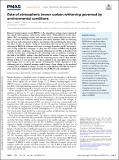| dc.contributor.author | Schnitzler, Elijah G | |
| dc.contributor.author | Gerrebos, Nealan GA | |
| dc.contributor.author | Carter, Therese S | |
| dc.contributor.author | Huang, Yuanzhou | |
| dc.contributor.author | Heald, Colette L | |
| dc.contributor.author | Bertram, Allan K | |
| dc.contributor.author | Abbatt, Jonathan PD | |
| dc.date.accessioned | 2023-03-16T17:06:57Z | |
| dc.date.available | 2023-03-16T17:06:57Z | |
| dc.date.issued | 2022 | |
| dc.identifier.uri | https://hdl.handle.net/1721.1/148579 | |
| dc.description.abstract | <jats:p>Biomass burning organic aerosol (BBOA) in the atmosphere contains many compounds that absorb solar radiation, called brown carbon (BrC). While BBOA is in the atmosphere, BrC can undergo reactions with oxidants such as ozone which decrease absorbance, or whiten. The effect of temperature and relative humidity (RH) on whitening has not been well constrained, leading to uncertainties when predicting the direct radiative effect of BrC on climate. Using an aerosol flow-tube reactor, we show that the whitening of BBOA by oxidation with ozone is strongly dependent on RH and temperature. Using a poke-flow technique, we show that the viscosity of BBOA also depends strongly on these conditions. The measured whitening rate of BrC is described well with the viscosity data, assuming that the whitening is due to oxidation occurring in the bulk of the BBOA, within a thin shell beneath the surface. Using our combined datasets, we developed a kinetic model of this whitening process, and we show that the lifetime of BrC is 1 d or less below ∼1 km in altitude in the atmosphere but is often much longer than 1 d above this altitude. Including this altitude dependence of the whitening rate in a chemical transport model causes a large change in the predicted warming effect of BBOA on climate. Overall, the results illustrate that RH and temperature need to be considered to understand the role of BBOA in the atmosphere.</jats:p> | en_US |
| dc.language.iso | en | |
| dc.publisher | Proceedings of the National Academy of Sciences | en_US |
| dc.relation.isversionof | 10.1073/PNAS.2205610119 | en_US |
| dc.rights | Creative Commons Attribution-NonCommercial-NoDerivs License | en_US |
| dc.rights.uri | http://creativecommons.org/licenses/by-nc-nd/4.0/ | en_US |
| dc.source | PNAS | en_US |
| dc.title | Rate of atmospheric brown carbon whitening governed by environmental conditions | en_US |
| dc.type | Article | en_US |
| dc.identifier.citation | Schnitzler, Elijah G, Gerrebos, Nealan GA, Carter, Therese S, Huang, Yuanzhou, Heald, Colette L et al. 2022. "Rate of atmospheric brown carbon whitening governed by environmental conditions." Proceedings of the National Academy of Sciences of the United States of America, 119 (38). | |
| dc.contributor.department | Massachusetts Institute of Technology. Department of Civil and Environmental Engineering | en_US |
| dc.relation.journal | Proceedings of the National Academy of Sciences of the United States of America | en_US |
| dc.eprint.version | Final published version | en_US |
| dc.type.uri | http://purl.org/eprint/type/JournalArticle | en_US |
| eprint.status | http://purl.org/eprint/status/PeerReviewed | en_US |
| dc.date.updated | 2023-03-16T16:54:16Z | |
| dspace.orderedauthors | Schnitzler, EG; Gerrebos, NGA; Carter, TS; Huang, Y; Heald, CL; Bertram, AK; Abbatt, JPD | en_US |
| dspace.date.submission | 2023-03-16T16:54:18Z | |
| mit.journal.volume | 119 | en_US |
| mit.journal.issue | 38 | en_US |
| mit.license | PUBLISHER_CC | |
| mit.metadata.status | Authority Work and Publication Information Needed | en_US |
